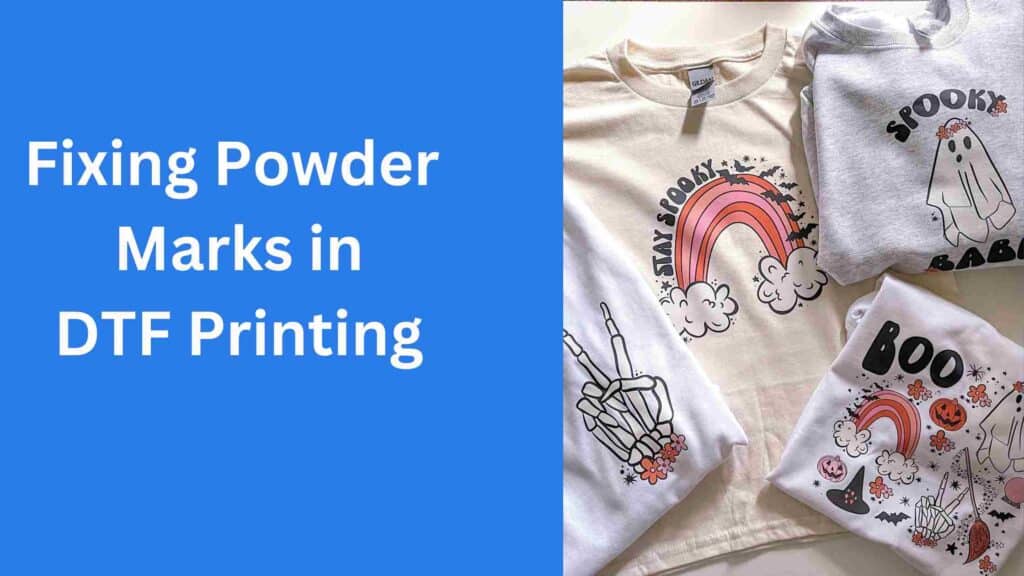Have you ever noticed powder marks on your DTF transfers? Do you often struggle to generate DTF prints of a good caliber? If so, you are not alone yourself. Powder marks on DTF transfers can be frustrating and detrimental to the final product.
For printing on textiles and other materials, DTF transfers are becoming more and more common. These transfers, however, need for a unique printing procedure that is prone to a number of problems. Powder marks on DTF transfers may cause print quality issues and product returns.
Thankfully, there are remedies for this issue, which we’ll look at in this post. You can produce high-quality DTF prints and provide your consumers items that live up to their expectations by putting these ideas into practice.

What are powder marks?
Powder markings are undesirable, noticeable lines or streaks that might appear on a DTF transfer during printing. These markings can appear randomly or in a predictable sequence and resemble white or light-colored lines. Powder marks are easiest to see on dark fabrics or surfaces because they stand out against the background color.
Excess toner or ink powder that sticks to the transfer paper and transfers to the cloth during the heat transfer process is what creates powder markings. If the toner or ink powder is not uniformly spread throughout the transfer paper or properly fused onto it, it might clump and leave these markings.
Printers and consumers dislike powder markings because they lower product quality. In order to avoid powder markings on DTF transfers, it is crucial to understand their causes. We’ll look at a few of the reasons why powder markings appear on DTF transfers in the next section.
Causes of powder marks on DTF transfers
- Improper pressure and temperature settings: During the printing process, incorrect pressure and temperature settings are one of the primary reasons of powder markings on DTF transfers. The toner or ink powder may not properly fuse into the transfer paper if the pressure is too high or the temperature is too low. This leads to clumping and powder markings. Prefer using a DTF powder shaker for best results.
- Low-quality transfer paper: Using low-quality transfer paper can also result in powder stains on DTF transfers. A transfer paper of poor quality absorbs extra toner or ink powder, creating clumping and unsightly markings.
- Low-quality ink or toner: Powder lines on DTF transfers can also be caused by using low-quality ink or toner. The printing process leaves powder markings if you do not powder the ink or toner finely.
- Printer maintenance: Powder marks on DTF transfers can also be caused by a dirty or poorly kept printer. Clumping and powder markings can occur from printer dust, debris, or excess toner or ink powder.
- Static electricity: Finally, static electricity can make toner or ink powder stick together and leave powder marks on DTF copies. Static electricity can be caused by a number of things, like low humidity or equipment that isn’t properly grounded.
Negative impact of powder marks on DTF transfers
Powder marks on DTF copies can make the end result look a lot worse. Some of the ways that powder marks can affect DTF moves are as follows:
- Powder marks can lower the quality of the print as a whole, making it look less professional and less appealing to customers.
- Reduced toughness: Powder stains can make the transfer paper more fragile and prone to ripping or peeling. As a result, there may be more returns or consumer complaints since the finished product is less durable.
- Wasted materials: Powder lines on DTF transfers can cause businesses to lose materials and time, which can be expensive.
- Powder lines on DTF transfers can lead to unhappy customers who may be less likely to buy from your business again.
By recognizing the detrimental effects of powder markings on DTF transfers, printers can avoid this problem and assure high-quality results. We’ll look at several ways to get rid of powder markings on DTF transfers in the following section.
Proposed Solutions
Solution 1: Adjusting the pressure and temperature settings
Changing the pressure and temperature settings during the DTF printing process is one way to get rid of powder marks on DTF transfers. The pressure and temperature should not be too high or too low for printers. To avoid clumping and powder markings, set the pressure and temperature correctly.
Printers should also use the right pressure and temperature for the transfer paper and fabric they’re utilizing. It’s vital to follow the manufacturer’s instructions for pressure and temperature settings since transfer papers and textiles vary. Also, use a heat press instead of Oven or heat gun for powder curing.
Solution 2: Using the right type of paper and ink
Using the proper transfer paper and ink might also help you get rid of powder stains on DTF transfers. Printers must make sure they are utilizing premium transfer paper that is intended just for DTF transfers. We have to coat the transfer paper with a thick layer and have the coating weight to absorb the proper quantity of ink or toner without clumping.
Additionally, printers should utilize premium ink or toner made especially for DTF transfers. We have to finely powder the ink or toner and equally fuse onto the transfer paper without clumps or powder markings.
Printers may decrease powder markings on DTF transfers and improve product quality and customer satisfaction by utilizing the correct transfer paper and ink.
Solution 3: Proper cleaning and maintenance of the printer
You can fix the powder lines on DTF prints by keeping the printer clean and in good working order. To eliminate extra toner or ink particles, we should clean our DTF printers periodically. This will stop the printing process from clumping and leaving powder stains.
Additionally, printers should repair any worn-out or broken components, such as the fuser or transfer belt. Worn or broken components might result in an uneven distribution of toner or ink, which can leave powder markings on the transfer paper.
By keeping the printer clean and well-maintained, printers can make sure it works well and makes high-quality DTF copies without powder marks.
Solution 4: Reducing static electricity during the printing process
Static electricity can be a big cause of powder marks on DTF transfers. The transfer paper charges with static electricity during printing, causing toner or ink powder to clump and leave powder streaks on the transfer.
You can take a few straightforward measures to reduce static electricity during the printing process. For example, they can use anti-static spray or wipes to keep the copy paper from getting too charged up. Dry air increases static electricity, thus it can humidify the printing space.
Another way to get rid of the static charge on the transfer paper is to use an ionization bar, which creates negative ions. This can be especially helpful in dry places where electricity builds up.
Printers can eliminate powder markings on DTF transfers and improve product quality and customer satisfaction by decreasing static electricity during printing.
Residue post pressing in DTF printing

While powder marks are a common issue in DTF printing, another issue that printers may encounter is residue post-pressing. The residue on the transfer paper is created by surplus ink or toner not being entirely transferred onto the fabric during pressing.
Printers can take several steps to prevent residue after pressing. First, they can make sure that they are using the right pressure and temperature settings during the pressing process. This is to make sure that the ink or toner is fully passed to the clothing. The improper transfer paper and ink might cause ink or toner accumulation, therefore printers should use the right ones.
Also, printers can try using a higher-quality transfer paper with a stronger layer weight. This can help keep ink or toner from building up on the transfer paper.
Last but not least, printers might attempt pressing on a Teflon sheet in order to prevent extra ink or toner from adhering to the transfer paper.
Conclusion
In conclusion, DTF printing often has problems with powder lines and dust after pressing. However, by using the right transfer paper and ink, adjusting pressure and temperature settings, properly maintaining the printer, reducing static electricity, and preventing residue post-pressing, printers can greatly reduce these issues and provide their customers with high-quality DTF transfers. By knowing about these possible problems and taking steps to avoid them, printers can make sure that their DTF printing projects go well.
FAQs
Powder lines on DTF transfers is because of a number of things, such as wrong settings for pressure and temperature, using the wrong type of transfer paper or ink, problems with printer maintenance, or static electricity.
We can change the pressure and temperature settings, use the right type of transfer paper and ink, keep their printer in good shape, reduce static electricity, and take steps to avoid leftovers after pressing to stop powder marks on DTF transfers.
Residue post-pressing occurs when surplus ink or toner is not entirely transferred onto the cloth during pressing.
We can utilize the right pressure and temperature settings, the right transfer paper and ink, a higher-quality transfer paper with a thicker coating weight, and a Teflon layer during pressing to avoid residue.

Ashley Wang is a skilled sales manager with knowledge in DTF printing. She presently works for ShenLan Digital, a reputable DTF printer maker. Ashley is the best person to offer advice on selecting the most suitable DTF printer because she has tested a lot of them. She launched DTFPrinterSchool to educate individuals and organizations about DTF printing technology, providing her expertise and observations on the most recent advancements in the sector. Ashley is an invaluable resource for businesses and individuals wishing to invest in DTF printing technology because of her expertise and experience in the industry.
